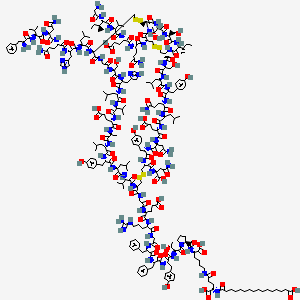

1. (1a-21a),(1b-29b)-insulin (human), 29b-(n6-(n-(15-carboxy-1- Oxopentadecyl)-l-gamma- Glutamyl)-l-lysine)-
2. Degludec
1. 844439-96-9
2. Degludec
3. Tresiba
4. Insulin Degludec [usan:inn]
5. Unii-54q18076qb
6. Nn 1250
7. Nn1250
8. B29n(epsilon)-omega-carboxypentadecanoyl-gamma-l-glutamyl Desb30 Human Insulin
9. 54q18076qb
10. (1a-21a),(1b-29b)-insulin (human), 29b-(n6-(n-(15-carboxy-1-oxopentadecyl)-l-gamma- Glutamyl)-l-lysine)-
| Molecular Weight | 6104 g/mol |
|---|---|
| Molecular Formula | C274H411N65O81S6 |
| XLogP3 | -4.9 |
| Hydrogen Bond Donor Count | 79 |
| Hydrogen Bond Acceptor Count | 92 |
| Rotatable Bond Count | 197 |
| Exact Mass | 6101.8431193 g/mol |
| Monoisotopic Mass | 6099.8364096 g/mol |
| Topological Polar Surface Area | 2510 Ų |
| Heavy Atom Count | 426 |
| Formal Charge | 0 |
| Complexity | 15300 |
| Isotope Atom Count | 0 |
| Defined Atom Stereocenter Count | 51 |
| Undefined Atom Stereocenter Count | 0 |
| Defined Bond Stereocenter Count | 0 |
| Undefined Bond Stereocenter Count | 0 |
| Covalently Bonded Unit Count | 1 |
Insulin degludec is indicated to improve glycemic control in patients 1 year of age and older with diabetes mellitus.
FDA Label
Treatment of diabetes mellitus in adults.
Insulin is a natural hormone produced by beta cells of the pancreas. In non-diabetic individuals, the pancreas produces a continuous supply of low levels of basal insulin along with spikes of insulin following meals. Increased insulin secretion following meals is responsible for the metabolic changes that occur as the body transitions from a postabsorptive to absorptive state. Insulin promotes cellular uptake of glucose, particularly in muscle and adipose tissues, promotes energy storage via glycogenesis, opposes catabolism of energy stores, increases DNA replication and protein synthesis by stimulating amino acid uptake by the liver, muscle and adipose tissue, and modifies the activity of numerous enzymes involved in glycogen synthesis and glycolysis. Insulin also promotes growth and is required for the actions of growth hormone (e.g. protein synthesis, cell division, DNA synthesis). Insulin detemir is a long-acting insulin analogue with a flat and predictable action profile. It is used to mimic the basal levels of insulin in diabetic individuals. The onset of action of insulin detemir is 1 to 2 hours and its duration of action is up to 24 hours. Interestingly, it has a lower affinity (30%) for the insulin receptor than human insulin.
A10AE06
A - Alimentary tract and metabolism
A10 - Drugs used in diabetes
A10A - Insulins and analogues
A10AE - Insulins and analogues for injection, long-acting
A10AE06 - Insulin degludec
Absorption
In patients with type 1 diabetes, after 8 days of once daily subcutaneous dosing with 0.4 U/kg, maximum degludec concentrations of 4472 pmol/L were attained at a median of 9 hours (tmax). After the first dose of, median onset of appearance was around one hour. The glucose lowering effect lasted at least 42 hours after the last of 8 once-daily injections. Insulin degludec concentration reach steady state levels after 3-4 days.
Clearance
The mean apparent clearance of insulin degludec is 0.03 L/kg (2.1 L/h in 70 kg individual) after single subcutaneous dose of 0.4 units/kg.
All insulin degludec metabolites are inactive.
The half-life after subcutaneous administration is determined primarily by the rate of absorption from the subcutaneous tissue. On average, the half-life at steady state is approximately 25 hours independent of dose.
Insulin detemir binds to the insulin receptor (IR), a heterotetrameric protein consisting of two extracellular alpha units and two transmembrane beta units. The binding of insulin to the alpha subunit of IR stimulates the tyrosine kinase activity intrinsic to the beta subunit of the receptor. The bound receptor autophosphorylates and phosphorylates numerous intracellular substrates such as insulin receptor substrates (IRS) proteins, Cbl, APS, Shc and Gab 1. Activation of these proteins leads to the activation of downstream signalling molecules including PI3 kinase and Akt. Akt regulates the activity of glucose transporter 4 (GLUT4) and protein kinase C (PKC), both of which play critical roles in metabolism and catabolism.